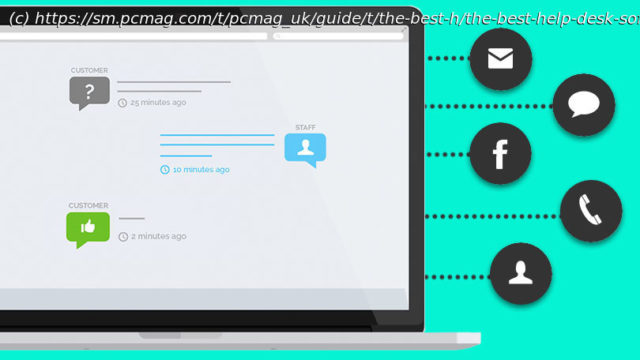Online commerce is at an all-time high during the pandemic, so keeping customers happy is more important than ever. We test and compare the top help desk services so you can choose what’s best for your business.
With more people shopping from home than ever, keeping customers happy without direct contact is an important mission for any retailer and many large, in-house IT service desk operations, too. S&P Global research is projecting online sales volume to rise to roughly 825 million in the US in 2022 up from approximately 450 million in 2018. With that kind of growth, effectively managing customer dissatisfaction is one of the most effective ways to grow your business. It’ll also be an important part of competing with rivals, too. The same goes for IT professionals servicing in-house employees and for the same reason, too. Hybrid work is going to stay with us long after the pandemic disappears, but that distributed model means there’s less chance of an IT pro being able to visit a user in person to solve problems. For this, a good help desk platform, particularly one that adheres to ITIL ( Information Technology Infrastructure Library) is going to be the crux of how IT departments keep their users happy and productivity steady. What Is Help Desk Software? Help desk software is the heartbeat of a well-run help desk and is a vital consideration for business owners. In fact, it’s one of a company’s top priorities whether that company is a small to midsize business (SMB) or a large organization. At the core, help desk solutions generally revolve around what’s called a ticketing system. The term “ticketing” refers to how customer or user problems reach service reps, namely as trouble tickets. Any complaint, no matter which channel is used to communicate it, gets put into a ticket format that contains all its basic information. That will include a problem summary, the customer ID, the time reported, what channel was used, and which service rep was assigned to work on it. How a system manages these tickets is the primary differentiator between help desk solutions. Fortunately, you are not short of options in this space. There’s a wide range of help desk software available, especially for SMBs. But even though many are focused on SMBs there are also solutions specializing in larger organizations and still others aimed at internal IT operations rather than organizations dealing with customer requests. With all those players, you’ll definitely find that not all help desk software will be equal. But what’ll differentiate one solution over another will often be dependent on your business’ individual needs rather than technology or product quality. For example, help desk software such as Freshdesk or Zendesk Support includes social tie-ins that let tickets be raised from social media websites such as Twitter. This could be an important feature to a company that deals with a large customer base but one not nearly as important (or even relevant) for one using the system simply as an internal IT service platform. Other help desk software, such as Jira Service Desk, provides additional security measures and identity management (primarily single sign-on or SSO) features, which may be key differentiators to some companies. SSO offers users the ability to create one set of log-in credentials for multiple applications. Keep an eye out for these types of security features. What is ITIL? During testing, we discovered that some help desk software stood out from the others in one important way: adherence to the Information Technology Infrastructure Library (ITIL). ITIL is an established service framework used mainly by IT management companies. It is a set of best practices that include many checklists, procedures, processes, and tasks. Having ITIL effectively govern how your company does things can be both constraining yet beneficial depending upon your particular industry. ITIL should be followed whenever possible, even if it does seem to be a bit overbearing for smaller enterprises. The help desk software tested falls into one of two camps: those that follow ITIL’s guidelines and those that don’t follow them. The more advanced services tested follow ITIL, including Freshservice, Jira Service Desk, and ManageEngine ServiceDesk Plus 9.3. They would make more sense to larger businesses working in the service management industry, perhaps overseeing data centers or large corporations in which service-level agreements (SLAs) and penalties are more than simple buzzwords. If your business follows ITIL, then you should opt for a help desk software offering that adheres to ITIL’s framework. But not all businesses that need help desk software follow ITIL or even need to. For example, if you are a software developer looking for something to handle incoming support requests from customers, then strong change management (something ITIL governs) probably isn’t something you need in a support desk. Conversely, Freshdesk, one of the help desk software offerings tested that doesn’t pay attention to ITIL, is not likely to be useful to a company that’s in charge of maintaining a large data center. Some businesses that don’t adhere to ITIL may focus more on customer service where tickets generated from social media are offered. These businesses would benefit from help desk solutions such as Cayzu, HappyFox, and Zendesk Support. So, first, determine whether or not ITIL is something your business needs to follow, and then shop accordingly. Chatbots Are the Future Most analysts have been predicting one trend as being a primary driver in the help desk space, and that’s artificial intelligence (AI). While that term means several things depending on which industry you’re discussing, in the customer service and help desk arena, it’s come to mean mainly chatbots. Chatbots are increasingly sophisticated software services that generally take over, or at least front, the live chat capability of your support website. Customers who initiate a live chat believe they’re discussing their problems with a real person, but are actually chatting with a chatbot-style “AI” that uses careful questions and natural language query processing to find out what the problem is. If possible, the chatbot resolves the issue itself, through a canned answer to a common problem, a display of alternate information resources, or some other AI-accessible methodology. If it can’t solve the problem, the chatbot simply hands off the customer to an actual person who is now armed with specific knowledge about the customer and the problem. It can even route the customer to the right customer service person based on that person’s expertise versus the customer’s issue. Sometimes the customers know about the handoff, sometimes a live person simply takes over for the chatbot and the customer is meant never to know the difference. The latest trend with chatbots is their evolution towards actual chatting. For example, at last year’s Cisco Contact Center Summit, Inference Solutions announced Inference Studio 6.






